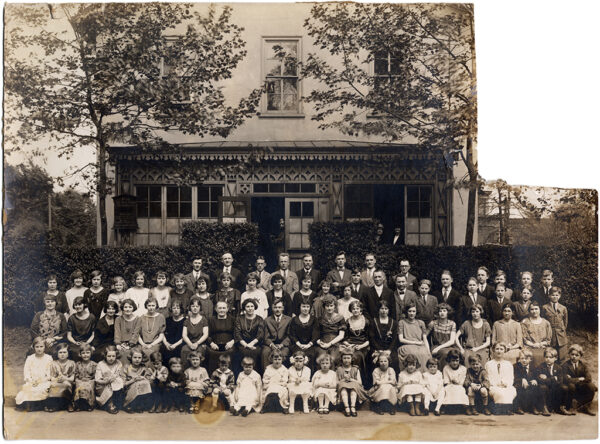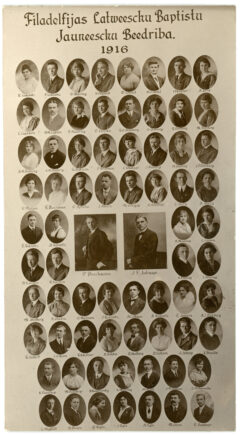
For more than two years, I have been pursuing research into the early immigrant Latvian Baptist press in North America, a topic that has seen almost no previous study. The research has come to focus on the specific community of Latvian Baptists who already by World War I had established a vibrant religious and cultural environment in West Philadelphia. In my hunt for primary sources, I happened upon the Buschman Family Papers held by the Immigration History Research Center Archives at the University of Minnesota. And in that collection I found a rarity: A photographic postcard from 1916 featuring the Rev. Peter Buschman and all 71 members of the Philadelphia Latvian Baptist Youth Society.
The image is the essence of a new digital project, Latvian Baptists in West Philadelphia.

At the outset, the project seeks to document the lives of the 72 individuals pictured and, by extension, of the larger Latvian Baptist community that was involved in the creation of periodicals such as Amerikas Latvietis (1903-1905), Jaunā Tēvija (1913-1917), and Drauga Balss (1917-1920). A key goal of the project is to not only tell the story of the community, but to suggest that the concentration of Latvian Baptists in a specific geography of Philadelphia was instrumental in the development of these publications.
The project was created as part of a graduate course in digital public humanities at George Mason University.
Using the photograph as a guide, data about members of the youth society has been gathered from 1910 and 1920 United States census records, as well as from naturalization papers and World War I draft registration cards. Most of these sources are available through the free-to-use FamilySearch.org, which is supported by The Church of Jesus Christ of Latter-day Saints. Some data also is being gathered through the commercial service Ancestry.com, as well as through the periodika.lv digital collection of the National Library of Latvia.
So far, biographical data for about half of the members has been located. It is hoped that as word of the project spreads, descendants and other community members will be able to assist in filling in the gaps. Census and other records provide basic facts, but what is missing are the stories of these immigrants. That’s No. 1 on the project’s “to-do” list.
As those who pursue genealogical research on immigrants to America can attest, locating individuals in census records can be challenging. Anglicization of immigrants’ names, either by the individuals themselves or by the authorities, at times resulted in inventive variations. This has been a consistent issue in locating Latvian immigrants. For example, the given name Jānis (or, in the “old” Gothic orthography, Jahnis) became John; the surname Mauriņš (or Mauriņsch) became Mauring.
The project uses the Omeka content management system created by the Roy Rosenzweig Center for History and New Media at George Mason University. It is a wonderful tool for creating digital collections, but “out of the box” cannot accomplish everything. Fortunately, Omeka has a growing body of plugins that extend its basic capabilities. For this project, the Exhibit Builder plugin was essential for creating the individual pages for members of the Latvian Baptist society. As more items are added to the collection (for example, a photograph or a document relating to an individual), the plugin will be invaluable for linking them to the biographies. Also important for the project is the Commenting plugin, which will allow visitors to the website to provide additional information about the individual society members. However, as the plugin did not automatically add this function to exhibit pages, some minimal PHP surgery was needed in Exhibit Builder.
This brings up another item for the “to-do” list for the project: Developing a unique Omeka template. For now, while initial research is conducted and information about the Latvian Baptists is added to the database, the default template that governs the exhibit’s display is good enough. Creating a distinctive template will help set this project apart and fix certain aspects that I find annoying from an aesthetic perspective.
Another aspect of the project is mapping the locations where society members and other Latvian immigrants lived in West Philadelphia. For now, a CartoDB map visualization is used to show where clusters of Latvians were located. My estimate is that up to 20 percent of Latvian immigrants who lived in Philadelphia around the time of World War I were Baptists, and most of them settled in West Philadephia. Their community also was tied to the agricultural “colony” in Bucks County to the north of Philadelphia, as well as to another one near the town of Yale in southern Virginia. Ideally, a future map will not only show where the Latvian Baptists lived, but allow the user to click on points to reveal who lived where, linking the markers to the biographic data.
The project, “Latvian Baptists in America, 1890-1940,” is found at straumanis.com/baptists.
Accessed on 23 Apr 2024.
The article may be found online at https://straumanis.com/2016/latvian-baptists/.
